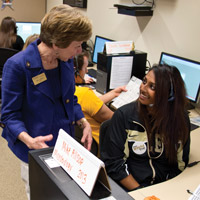RETHINKING TEACHING
HOW HHS PROFESSORS ARE USING NEW TOOLS AND CLASSROOM STRATEGIES TO DELIVER HIGHER EDUCATION
EDUCATION OF THE MASSES

Withstanding the Heat: With a student audience of 200-plus, Elliot Friedman, assistant professor of human development and family studies, is using Hotseat in his Human Development class. The social media tool allows students to post comments and questions via Facebook and Twitter. (Photo by Andrew Hancock)
You may recall crowding into a large lecture hall in your own college days, elbow to elbow with some 200-plus restless, sometimes sleepy, 18- to 20-year-olds. These settings present learning challenges — for both professor and pupils. "It feels lousy when you lose an audience of 200 students," Karpicke says.
Though he probably hasn't lost too many audiences. One of five Purdue teachers honored with a 2011 Outstanding Undergraduate Teaching Award in Memory of Charles B. Murphy, Karpicke tries to keep students personally engaged in the heady material.
"In any of the big foundational courses students are going to be responsible for a lot of content that's brand-new to them," Karpicke says. "So I try to make it relevant. Cognitive psychology is about how the mind works and I'm talking to a bunch of people with minds, so I'll spend a lot of time talking about learning strategies."
Hollich, Karpicke's colleague in psychology, uses a tool called Hotseat in his Introduction to Child Psychology class. The Purdue-built backchannel system allows students to post comments and questions via Facebook and Twitter. And in Hollich's case, that's a chance to hear from all of the 155 students enrolled.
In spite of some initial challenges, such as getting all the students to enter their phone numbers into Hotseat for attendance purposes, Hollich is thrilled with the response he's getting from his students. "Often the things that are most misunderstood are not the things the top students would ask in a large class," he says. "My principal use of Hotseat is to have students to text me one thing they had trouble understanding or one question they would like answered at the end of the class. This gives me a better picture of exactly where students are having difficulty and what topics need more lecture."
For Shields, who teaches Human Sexuality and the Family to a class of 77, Hotseat helped create a dialogue that was previously unattainable in a large class, especially one with a subject matter that may make some students reluctant to speak their minds. "I alternate my lecture between PowerPoint and discussing Hotseat comments," he says. "There's never been a shortage of comments or questions."
Both early adopters of Hotseat, Hollich and Shields have adjusted their teaching styles accordingly. But both seem enthusiastic about the apparent educational sea change — and where it's leading them. "Teaching and learning is all about engagement," says Hollich, who won Purdue's Class of 1922 Helping Students Learn Award for teaching a traditional course in a nontraditional way in a program called IMPACT, which stands for Instruction Matters: Purdue Academic Course Transformation. "These days students are turning to technology as another method to share their thoughts, questions and ideas. These new technological tools help us connect with students — pure and simple. We understand how much and exactly what they're learning.
In the past, we could've had students write short response papers or ask them to speak up in class, but this new technology gives us instantaneous feedback from all students in the classroom. It's just a better tool, and I can't see why more teachers don't use it. It's like digging a hole with a spoon instead of a shovel. Why not use the best tool to do the best job?"











